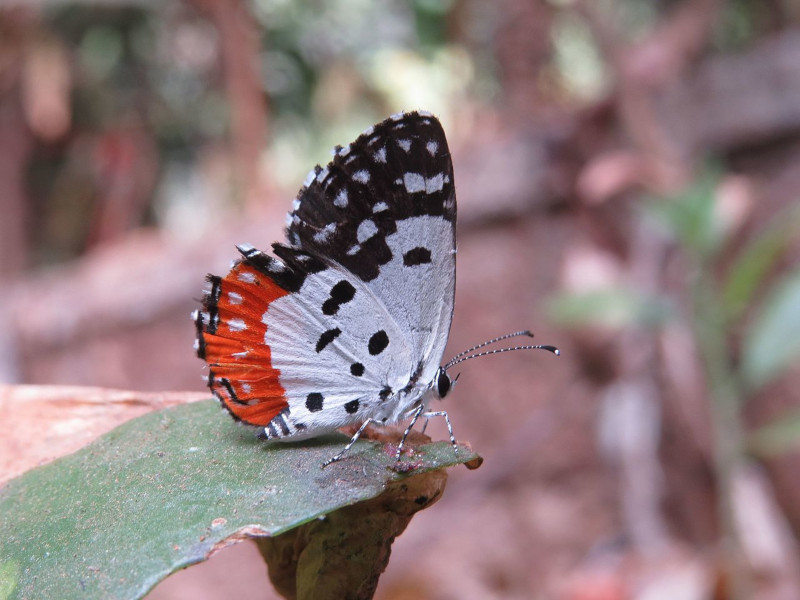
Red Pierrot Facts
- The perfectly descriptive term of the Red Pierrot serves as the accepted common name for a beautiful variety of Lepidoptera. This small marvel of Nature, like many species, remains better known to researchers by its scientific name, however.
- That term, remains that of the somewhat hard to pronounce Talicada nyseus. Regardless of which of these names you use to refer to it, though, this particular species of butterfly has one of the most striking color patterns of any of its kind.
- The first official recognition of this creature as a separate and distinct species occurred in the year 1843. The formal credit for this fortuitous identification goes to the well known and renowned French entomologist, Félix Édouard Guérin – Méneville.
- It also forms a member of the Lycaenidae family, the second-largest of all Families of butterflies, with more than 6,000 member species. Quite fortunately, the gorgeous invertebrate known as the Red Pierrot, has an advantage over many related species.
- This magnificent insect appears to be maintaining a sufficient and stable population throughout the entirety of its natural range. The IUCN therefore currently has no listing for this invertebrate on the organization’s Red List of Threatened Species.
- This wonder of evolution must nevertheless be considered to be at some risk, at least. This regrettable situation primarily occurs due to a combination of two different threats. Sadly, either one of these would be enough to place it in peril.
- Firstly, the truly beautiful insect currently faces the problem posed by increasing habitat loss. Secondly, though, the greatest threat to its continued existence most likely comes in the form of ongoing climate change, like many creatures.
Related Articles
Lange’s Metalmark Butterfly
Red Pierrot Physical Description
Perhaps most notably, although the Red Pierrot ranks high among its kindred in terms of beauty, it does not do so in terms of sheer physical size. In point of fact, this particular species of Lepidoptera ranks as a smaller than average type of butterfly.
However, this sincerely lovely arthropod does have one trait in common with its kindred, of all sizes. That holds true due to the fact that this specific invertebrate displays a slight degree of the physiological characteristic of sexual dimorphism.
In this instance, though, that physical trait manifests itself in terms of overall physical size. That holds true because of the fact that the females of this specific butterfly generally attain a slightly greater physical size than that of the males of the species.
Overall, adults attain an average wingspan of 1.2 – 1.4 in (3 – 3.5 cm). In other respects, the genders remain indistinguishable from each other. The upper section of the wing appears black, with the exception of a prominent orange section of the hindwing, on the lower edge.
In the meantime, the underside of the wings of the stunning Red Pierrot is something entirely different. That’s partly because the forewing show white, with black spots. This makes for a truly striking appearance for this insect to show the world.
Meanwhile, though, the hindwing of the butterfly has the same basic pattern of black spots. But a difference also occurs. These black spots also appear along with a wide band of orange. Finally, multiple white spots also appear quite prominently.
- Kingdom: Animalia
- Phylum: Arthropoda
- Class: Insecta
- Order: Lepidoptera
- Family: Lycaenidae
- Genus: Talicada
- Species: T. nyseus
Red Pierrot Distribution, Habitat, and Ecology
The Red Pierrot inhabits a moderate-sized portion of the world, for a butterfly. That’s because of the fact that it appears in a wide swathe of Asia. More precisely, this truly magnificent arthropod inhabits an area includes the great majority of the country of India.
But, the visually marvelous little creature also appears in the foothills of the Himalayas, as well as the northern section of the country of Myanmar. Within this extensive range, however, the animal continues to be quite flexible in its choice of habitat.
That statement rings true given the fact that it appears in widely varied regions. In point of fact, this stunning arthropod lives in such varied regions as areas of degraded evergreen forests, semi-arid plains, mountains, and even private gardens.
The quite beautiful Red Pierrot inhabits any and all of these regions within its range, provided that the location meets two requirements. Firstly, the insect inhabits areas with an altitude ranging from sea level up to no more than roughly 8,000 ft (2,438 m).
Secondly, any of these areas must also have an abundance of the plant Kalanchoe. Thirdly, this is an important requirement for the remarkable species. This occurs since the fascinating invertebrate evolved a high degree of dependency upon a single type of flora.
The supremely magnificent Red Pierrot further developed as almost entirely dependent on this very specific plant. That’s true because the females lay their only eggs on its leaves, and individuals of all ages depend on it as their source of food.
Species Sharing Its Range
Check out our other articles on Earth’s Many Stunning Waterfalls, Blue Footed Booby, Coyote Gulch, Adenium Flower Bonsai, Pallid Bat, Rabid Wolf Spider, Weedy Seadragon, Plumed Basilisk
